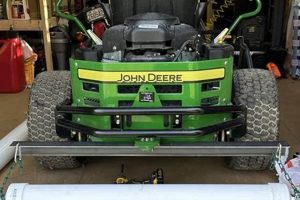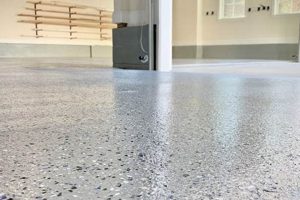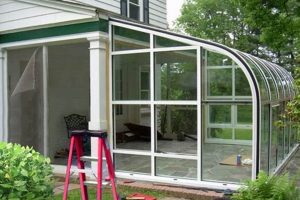A homemade percussion instrument set, often constructed from repurposed or unconventional materials, allows individuals to create rhythms and sounds. For example, a collection of buckets, pots, and pans arranged to mimic a traditional drum set configuration would qualify.
The practice fosters creativity, resourcefulness, and an understanding of sound production. Historically, such endeavors have offered accessible musical expression where financial constraints limit access to professionally manufactured instruments, promoting musical exploration and innovation.
This exploration into sound creation can involve diverse construction methods and material selection, offering builders the opportunity to tailor the instrument to specific sonic preferences and playing styles, opening avenues for unique musical expressions.
Construction and Optimization Advice
Considerations for the creation of a percussion instrument ensemble from repurposed materials require careful planning and execution. The following guidance addresses critical aspects of the building process.
Tip 1: Material Selection: Prioritize materials based on sonic properties and durability. Metal provides bright tones, while wood offers warmer, resonant sounds. Ensure structural integrity to withstand repetitive striking.
Tip 2: Tuning Considerations: Explore adjusting tension and dampening materials to manipulate pitch and sustain. Tightening drumheads or adding padding alters the instrument’s sound profile.
Tip 3: Configuration and Ergonomics: Arrange components to facilitate comfortable and efficient playing. Mimicking standard drum set layouts or creating custom configurations based on personal preference is advisable.
Tip 4: Dampening Techniques: Implement methods to control unwanted overtones or ringing. Applying tape, cloth, or other dampening materials affects the sustain and clarity of the sound.
Tip 5: Mounting and Stability: Securely mount all components to prevent movement during playing. Stable mounting ensures consistent sound quality and prevents damage to the instruments.
Tip 6: Beater Selection: Experiment with different beaters to achieve various tones and attack characteristics. Consider using wooden sticks, mallets, or other implements to influence the resulting sound.
Tip 7: Safety Precautions: Exercise caution when cutting, drilling, or assembling materials. Wear appropriate safety gear to prevent injuries.
Following these guidelines results in a more refined and playable homemade drum kit, maximizing its sonic potential and ensuring long-term usability. Careful attention to detail enhances the overall musical experience.
This refined understanding facilitates exploration into advanced building techniques and creative sound design, empowering builders to expand their musical horizons.
1. Materials
Material selection forms the foundation of a homemade percussive setup, profoundly affecting sound quality, durability, and overall aesthetic. The materials chosen dictate the instrument’s tonal characteristics and longevity, influencing the player’s expressive range and the instrument’s resilience to wear and tear.
- Resonance Properties
Different materials exhibit distinct resonant frequencies, directly impacting the instrument’s timbre. Metal, for example, tends to produce brighter, more ringing tones, while wood yields warmer, more muted sounds. Material density and shape further influence these resonant qualities, dictating the instrument’s sonic signature.
- Durability and Longevity
The inherent strength and resistance to degradation of the chosen materials determine the instrument’s lifespan. Materials susceptible to cracking, warping, or rusting compromise the instrument’s structural integrity and sonic performance over time. Employing durable and weather-resistant materials extends the instrument’s usability.
- Acoustic Properties
Materials vary in their ability to project and amplify sound. Hollow enclosures, such as repurposed containers, can act as resonators, enhancing the instrument’s volume and sustain. Conversely, dense, non-resonant materials may dampen vibrations, resulting in quieter, more controlled tones.
- Accessibility and Cost
The availability and cost-effectiveness of materials significantly influence the feasibility and accessibility of creating a homemade percussion instrument. Repurposed or recycled materials offer a cost-effective alternative to commercially manufactured components, promoting resourcefulness and reducing environmental impact.
In summary, a thoughtful approach to material selection optimizes both the sonic potential and practical viability of a homemade percussive instrument. Prioritizing resonant properties, durability, acoustic characteristics, and affordability results in an instrument that is both musically expressive and structurally sound, extending the instrument’s lifecycle and enhancing the player’s creative possibilities.
2. Construction
Construction, in the context of a homemade percussive instrument ensemble, dictates the instrument’s functionality, durability, and ultimately, its sound. The methods employed to assemble various components directly influence the instrument’s resonance, stability, and playability. For example, a drum constructed with poorly secured heads will produce a dampened, uneven sound and be prone to failure. Conversely, precise construction techniques, utilizing appropriate adhesives and reinforcement, result in a more resonant, robust, and dependable instrument.
A real-world illustration of this principle is found in contrasting approaches to creating a homemade snare drum. A rudimentary snare drum might consist of a repurposed bucket with a loosely attached snare mechanism. Such a construction is likely to produce a weak, muffled sound with minimal snare response. However, a more elaborate construction, utilizing a reinforced shell, a precisely tensioned head, and a carefully positioned snare mechanism, offers a far more articulate and responsive sound, approaching the performance of a commercially produced instrument. The significance lies in the meticulous application of construction principles to transform raw materials into a functional musical instrument.
In conclusion, construction is not merely an assembly process, but a critical determinant of the instrument’s sound and longevity. Challenges arise in identifying suitable materials and techniques to achieve desired sonic characteristics and structural integrity. A thorough understanding of construction principles is thus indispensable for effectively creating a functioning percussive setup, realizing its sonic potential, and ensuring its enduring usability. This understanding is the cornerstone for further exploration and innovation within the re
alm of homemade musical instruments.
3. Sound Quality
The sonic attributes of a homemade percussive ensemble are paramount, directly influencing the overall musical experience and creative potential. Achieving desirable sound quality demands careful consideration of various interconnected factors, each playing a critical role in shaping the instrument’s unique sonic signature.
- Material Resonance and Timbre
The inherent resonant frequencies of the materials employed directly impact the instrument’s timbre. For example, a metal container struck as a drum produces a bright, ringing tone, while a wooden surface generates a warmer, more muted sound. Material selection thus dictates the instrument’s fundamental sonic character, influencing its capacity to blend with other instruments or stand alone.
- Tuning and Pitch Control
The ability to manipulate the pitch of individual components is crucial for creating a cohesive percussive soundscape. Tensioning drumheads, for instance, allows for precise tuning, enabling the creation of melodic rhythms and harmonic intervals. Conversely, a lack of tuning options limits the instrument’s expressive potential, restricting it to a narrow range of fixed tones.
- Dampening and Sustain Control
Managing the duration and decay of sound is essential for achieving clarity and preventing unwanted overtones. Applying dampening materials, such as tape or cloth, to resonant surfaces shortens the sustain and focuses the sound, while removing dampening agents allows for longer, more sustained tones. Skillful dampening techniques contribute to a more controlled and articulate sound.
- Acoustic Projection and Volume
The ability of the instrument to project sound effectively determines its audibility in various performance contexts. Hollow enclosures, such as repurposed containers, act as resonators, amplifying the sound and increasing its volume. The size, shape, and material composition of these resonators directly influence the instrument’s acoustic projection capabilities.
The interplay of these elements collectively defines the sonic attributes of the homemade percussion instrument. The pursuit of optimal sound quality within the realm of homemade musical instruments necessitates a comprehensive understanding of these factors and a willingness to experiment with different materials, construction techniques, and tuning methods. Achieving a balanced and expressive sound contributes significantly to the instrument’s overall musical value, expanding the possibilities for creative expression.
4. Tuning
Tuning is a crucial yet often challenging aspect of constructing a functional percussive setup. While manufactured drum kits possess standardized tuning mechanisms, a constructed instrument set requires alternative, resourceful approaches to achieve desired pitches and tones. The capacity to alter and refine the sonic output of each component dictates the potential musicality. Without tuning capabilities, the sound remains static and limited. An effective tuning approach enables the creation of melodies, harmonies, and rhythmic variations.
The practice of tuning a bucket-based bass drum, for example, might involve altering the tightness of the material stretched across its opening. Securing material more tightly results in a higher pitch, while a looser fitting yields a lower tone. A constructed instrument set using pots and pans can achieve varied pitches by striking different sized or shaped cookware. A more sophisticated solution involves employing tensioning devices, such as clamps or adjustable straps, to fine-tune the sound. The effect of any particular tuning adjustment can be tested using a chromatic tuner or by ear.
Tuning is integral to realizing the musical potential of a self-constructed percussion instrument. It overcomes the inherent limitations of the chosen materials and allows for the creation of a nuanced and expressive instrument. The skill to manipulate and refine pitch transforms a collection of repurposed objects into a functional and versatile instrument. This understanding underscores the importance of adaptability and creativity in realizing sound qualities.
5. Durability
Durability is a critical factor influencing the long-term viability and practical utility of a constructed instrument set. The materials chosen and the construction techniques employed directly determine the instrument’s ability to withstand repeated use and environmental factors. Insufficient durability leads to premature failure, diminished sound quality, and ultimately, renders the instrument unusable. For example, a drum constructed from thin, brittle plastic is likely to crack or shatter under sustained percussive force, negating its musical function. Conversely, the careful selection of robust materials and the implementation of reinforced construction methods extend the instrument’s lifespan and maintain its performance quality over time.
Consider a homemade cymbal crafted from a repurposed metal lid. A thin, flimsy lid will warp and potentially tear with repeated striking, producing a dull, distorted sound. However, a thicker, more resilient metal disc, properly mounted and supported, will withstand the impact and generate a clearer, more sustained tone. This illustrates the direct cause-and-effect relationship between material quality, construction integrity, and the resultant durability of the instrument. Proper attention to durability considerations translates to a more reliable and enjoyable musical experience.
In summary, durability is not merely a desirable attribute but a fundamental requirement for any functional instrument set. The investment of time and resources in selecting durable materials and employing robust construction techniques is essential for maximizing the instrument’s lifespan and ensuring its continued usefulness. Overlooking durability concerns can lead to frequent repairs or replacements, undermining the value and sustainability of the entire project. The link between durability and functionality is critical for the success of the build.
6. Ergonomics
Ergonomics plays a crucial role in the design and usability of percussion instruments, particularly within the context of constructed instrument sets. The efficient arrangement of components minimizes strain and maximizes playability, directly influencing the musician’s comfort, performance quality, and risk of injury.
- Component Placement and Reach
The positioning of each percussive element significantly affects the player’s reach and range of motion. Components placed too far apart or at awkward angles necessitate excessive stretching or twisting, leading to fatigue and potential strain injuries. Arranging instruments within a comfortable and easily accessible radius promotes fluid movement and reduces physical stress.
- Seating and Posture
Proper seating and posture are fundamental to ergonomic playing. A
stool or chair of appropriate height allows the player to maintain a neutral spine and relaxed shoulders, minimizing back pain and promoting efficient limb movement. Adjustable seating options accommodate varying body sizes and playing styles, optimizing comfort and control. - Striking Surface Height and Angle
The height and angle of the striking surfaces impact wrist and arm positioning. Surfaces that are too high force the player to overextend their reach, while surfaces that are too low necessitate excessive bending. Adjusting the height and angle of individual components to match the player’s natural arm swing minimizes strain and maximizes striking efficiency.
- Weight and Stability of Components
The weight and stability of individual percussive elements influence the player’s control and effort required to produce sound. Lightweight components that are prone to shifting or tipping necessitate constant readjustment, diverting attention and energy away from musical performance. Securing components and ensuring their stability enhances control and reduces the risk of accidental movement.
The considerations outlined represent a significant aspect of instrument building. The overall effect of ergonomic design leads to enhanced musical enjoyment. The long-term physical health of the user is linked to the design.
7. Creativity
The constructed instrument set inherently relies on creative ingenuity. The absence of standardized components and pre-defined construction methods necessitates resourcefulness and innovative problem-solving. The creation of percussive instruments from unconventional materials demands a departure from established norms, fostering an environment where originality is paramount. This creativity manifests in material selection, construction techniques, tuning methodologies, and aesthetic design, resulting in unique and personalized instruments. The cause is a lack of typical resources; the effect is creative problem solving.
Consider the example of a musician repurposing discarded industrial pipes into tuned percussion tubes. This undertaking requires imagination to envision the potential sonic properties of the materials, engineering skills to cut and arrange the pipes to achieve specific pitches, and artistic vision to create a visually appealing instrument. Similarly, the construction of a drum set from repurposed containers demands creative adaptation to overcome the limitations of the materials and achieve a playable configuration. The practical application is the ability to create instruments that are both functional and artistically distinctive. An emphasis on creativity makes this project worthwhile.
The connection between creativity and instrument building extends beyond mere functionality. The process of creating an instrument fosters a deeper understanding of sound production, instrument design, and musical expression. Challenges arise in effectively translating creative ideas into tangible and functional instruments. Ultimately, the constructed instrument set exemplifies the power of creative thinking to transform discarded materials into sources of musical inspiration and innovation.
Frequently Asked Questions About DIY Drum Kits
The following section addresses common inquiries regarding the construction, functionality, and sonic properties of percussive instruments created from repurposed materials.
Question 1: What materials are best suited for constructing a durable and resonant drum?
Dense hardwoods and metals offer superior resonance and durability. Plastics may be employed, but their longevity is typically inferior. The specific choice depends on the desired tonal characteristics and the intended application.
Question 2: How can one effectively tune a homemade drum?
Tuning involves adjusting the tension of the striking surface. This can be achieved using adjustable straps, clamps, or by altering the mounting configuration. Experimentation is often necessary to achieve the desired pitch.
Question 3: What are the essential tools needed for building a basic instrument set?
A saw, drill, measuring tools, and fastening hardware are typically required. The specific toolset depends on the complexity of the design and the materials employed.
Question 4: How can unwanted overtones and ringing be minimized?
Dampening materials, such as tape, cloth, or foam, can be applied to the striking surface to reduce sustain and control unwanted frequencies. Strategic placement of dampening materials is key to achieving a balanced sound.
Question 5: What are the safety precautions to observe during construction?
Eye protection, gloves, and appropriate respiratory protection should be worn when cutting, drilling, or handling potentially hazardous materials. Power tools must be used according to manufacturer’s instructions.
Question 6: How can a beginner start building a percussion instrument set?
Begin with simple designs and readily available materials. Online resources and instructional videos provide guidance on basic construction techniques. Start small and gradually increase complexity as experience is gained.
Careful planning and execution are vital for success. Each constructed element holds unique possibilities, and should reflect the sound that is trying to be realized.
This FAQ should provide a clear path for the building of instruments. Additional resources exist and provide more detailed instruction.
Conclusion
The exploration of the “diy drum kit” reveals a convergence of resourcefulness, musicality, and creative problem-solving. Material selection, construction techniques, tuning considerations, durability enhancements, ergonomic design principles, and innovative expression form the cornerstone of this endeavor. Understanding these elements empowers individuals to transform discarded materials into functional and expressive instruments.
The constructed instrument set represents a testament to human ingenuity and the transformative power of music. Continued exploration and refinement of these techniques will undoubtedly yield further advancements in accessible musical instrument design and foster greater appreciation for the intersection of art, science, and sustainability. The construction process remains important.







